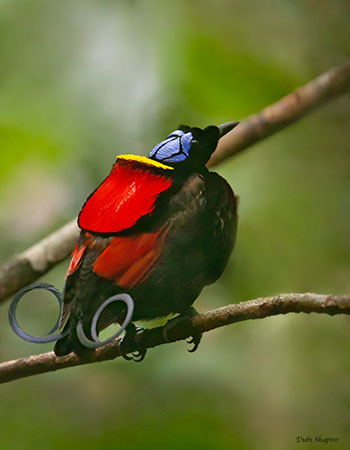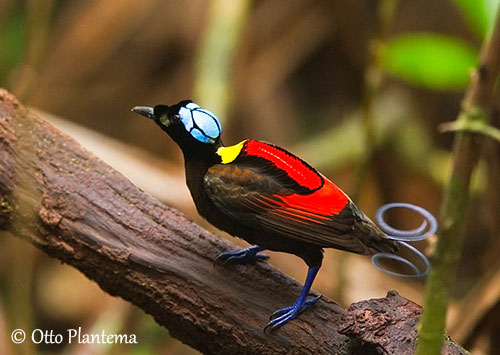
Fr: Paradisier républicain
Ang: Wilson's Bird-of-paradise
All: Nacktkopf-Paradiesvogel
Esp: Ave del Paraíso Republicana
Ita: Uccello del paradiso di Wilson
Nd: Wilsons Paradijsvogel
Sd: wilsonparadisfågel
Photographers:
Otto Plantema
Trips around the world
Dubi Shapiro
Dubi Shapiro Photo Galleries
Text by Nicole Bouglouan
Sources:
HANDBOOK OF THE BIRDS OF THE WORLD Vol 14 by Josep del Hoyo-Andrew Elliot-David Christie - Lynx Edicions – ISBN: 9788496553507
Les Oiseaux de paradis – Histoire Naturelle et photographies - par Michel Ottaviani - Editions Prin, France – ISBN : 2-909136-40-X
Birds of Paradise and Bowerbirds De Phil Gregory – Editeur: Bloomsbury Publishing, 2020 – ISBN: 1472975847, 9781472975843 – 416 pages
Birds of New Guinea: Second Edition De Thane K. Pratt, Bruce M. Beehler – Editeur: Princeton University Press, 2014 – ISBN: 0691095639, 9780691095639 – 528 pages
Birds of New Guinea: Distribution, Taxonomy, and Systematics De Bruce M. Beehler, Thane K. Pratt – Editeur: Princeton University Press, 2016 – ISBN: 069116424X, 9780691164243 – 672 pages
Book of Curious Birds De Jennifer Cossins – Editeur: Hachette UK, 2021 – ISBN: 073442048X, 9780734420480 – 64 pages
Astonishing Animals: Extraordinary Creatures and the Fantastic Worlds They ... De Tim Flannery – Editeur: Open Road + Grove/Atlantic, 2012 – ISBN: 0802194176, 9780802194176 – 192 pages
Bird: The Definitive Visual Guide De DK – Editeur: Dorling Kindersley Ltd, 2022 – ISBN: 0241596319, 9780241596319 – 512 pages
Pupperish - The Wilson's Bird Of Paradise Is Utterly Exquisite
Charismatic Planet - The Gorgeous Wilson Bird of Paradise
Like a jewel in the wilderness
Jungle Dragon
CREAGUS@Monterey Bay (Don Roberson)
Fatbirder - The World’s Richest Information Resource about Birds for Birders
Wikipedia, the free encyclopaedia
Wilson's Bird-of-paradise
Diphyllodes respublica
Passeriformes Order – Paradisaeidae Family
INTRODUCTION:
The Wilson's Bird-of-paradise is one of the most beautiful birds-of-paradise. The male’s plumage is brightly coloured and the elongated tail feathers resembling double leaf, make this bird absolutely amazing. The female has much more cryptic plumage, well-adapted to the nesting duties.
The Wilson's Bird-of-paradise is an Indonesian endemic found in hill and lowland rainforests of Waigeo and Batanta Islands, off West Papua. It feeds on fruits, insects and small invertebrates.
The courtship displays are spectacular and take place in a “display court” cleaned by the male itself. Songs and calls accompany the mating dance.
The scientific term “respublica” was given by Charles Lucien Bonaparte who was the nephew of Napoleon, and a staunch republican with anti-monarchy sentiments.
The English name “Wilson” pays tribute to Edward Wilson, a British ornithologist.
The Wilson's Bird-of-paradise is affected by habitat loss and the species is currently listed as Near Threatened.

DESCRIPTION OF THE BIRD:
Biometrics:
Length: M: 16 cm (21 cm with central rectrices) – F: 16 cm
Weight: M: 53-67 g – F: 52-60 g
The Wilson's Bird-of-paradise adult male is the most colourful of this family, with a wonderful rainbow of colours.
On the upperparts, we can see a semicircular, bright yellow cape on the upper mantle, whereas rest of mantle is crimson and bordered by a black line.
On the upperwing, the blackish-brown lesser coverts are broadly edged pale brown. Both greater coverts and alula are darker brown, finely edged dark crimson. The tertials are dark crimson with black tips. The secondaries are brownish-black with dark crimson leading edges, and the dark brown primaries also show fine crimson leading edges.
Rest of upperparts including rump, uppertail-coverts and uppertail are blackish-brown. On the tail, the central rectrices are modified and similar to “sickles”. They are iridescent violet-purple with magenta sheens.
On the underparts, the velvety black chin and upper throat show coppery-bronze to purple gloss. A large breast shield made of smooth, glossy emerald-green plumage extends from mid-throat to belly. This colour may vary depending on the light. We can see several turquoise-green spots and feather’s tips throughout the shield.
Rest of underparts is sepia-brown with violet-purple sheen.
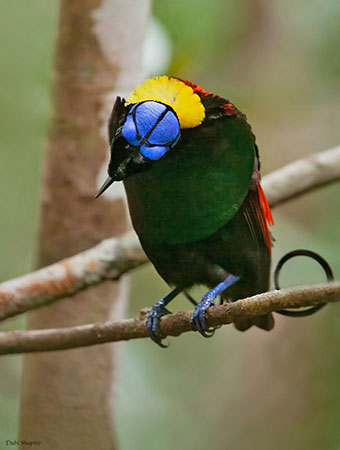
On the head, there is a tuft of velvety black feathers around the bill base. Crown and nape are naked, with a bright turquoise-blue skin with criss-crossing black lines of fine black feathers showing copper-bronze iridescent sheens.
The bill is blackish with the upper ridge of culmen similar to knife edge. The gape is pale yellow whereas the mouth is bright yellow to green. The eyes are dark brown. Legs and feet are cobalt-blue to blue-grey.
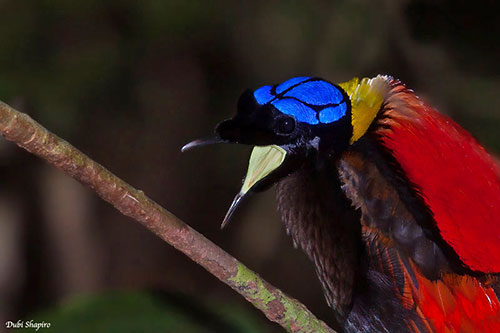
The adult female is much duller than male. Crown and nape are also naked but darker and less extensive. The upperparts are dark olive-brown to reddish-brown, and more rusty on uppertail-coverts. The tail is longer than that of male, and the modified central rectrices are absent. Uppertail and upperwing are brown with narrow rusty edges to flight-feathers. The primaries are duller and greyer.
On the underparts, the chin is pale buff with fine greyish flecks. The underparts are buff and barred brown-black.
The legs are duller than in adult male.
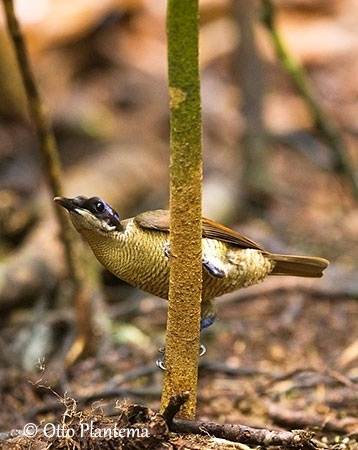
The immature male resembles female but the rectrices are pointed at tip. While growing, the young male acquires shorter rectrices, while the central pair is becoming progressively longer.
RANGE:
The Wilson's Bird-of-paradise is endemic to Indonesia. It is found on Waigeo and Batanta Islands, off West Papua.
HABITAT:
The Wilson's Bird-of-paradise frequents mainly the hill forests, up to 300 metres of elevation. It is more rarely observed in lowland rainforest and middle mountain forest. Occasionally up to 1,200 metres.
CALLS AND SONGS: SOUNDS BY XENO-CANTO
The advertising call of the Wilson's Bird-of-paradise is a clear, loud, whistled note described as “cheew”, “chow” or “twou” audible at a distance of 1-2 kilometres. This call may be given in series of sharper, metallic clicks sometimes followed by 3 clearer and sharper clicks.
We can hear other types of calls such as sharp, explosive “keeetch”, also a repeated soft whistle “teel”, a stronger “too-too-too-too-too-too-wit” with higher-pitched last note.
During the spectacular displays, the male produces complex squeaky twittering interspersed with guttural notes.
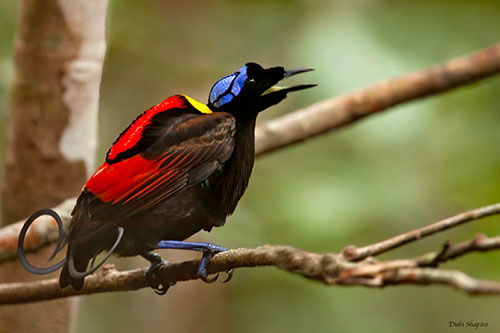
BEHAVIOUR IN THE WILD:
The Wilson's Bird-of-paradise feeds mainly on fruit, small insects, small arthropods and small invertebrates.
The members of the subfamily Paradisaeinae use their feet as tools to hold and manipulate food items. The fruits are harvested while perched, rarely in flight. These birds are good dispersers of seeds because they do not digest them.
But the foraging behaviour of the present species is currently poorly known.
The Wilson's Bird-of-paradise is polygynous and mates with several females. The female performs alone all the nesting duties.
In order to attract females, the male creates an area or court up to a metre wide, within the dense forest. It is usually a small, well-lit clearing around a fallen tree. This area is continuously cleaned by the male which removes leaves and debris from the forest floor.
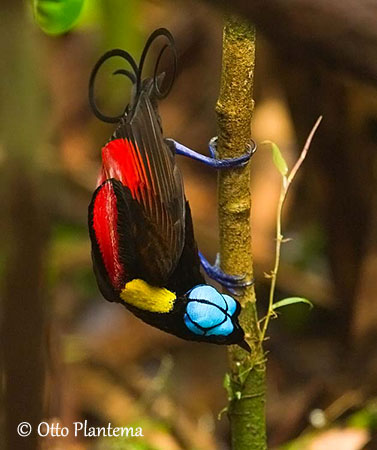
When a female approaches, the male adopts first a “frozen” posture on the base of a vertical small tree. Then, the displays include static and leaning postures, and the bird dances while moving its nuchal nape and the breast shield, the head and the highly modified central rectrices. Gaping is also performed to expose the bright yellow-green mouth.
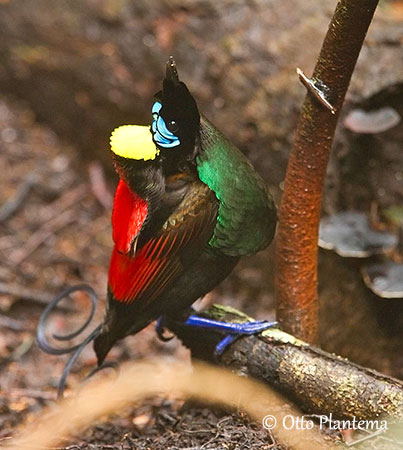
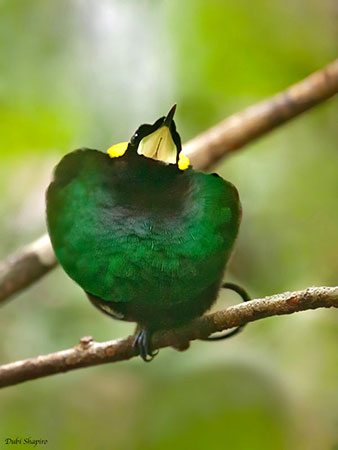
These displays are accompanied by squeaky twittering, calls, chatters and buzzing towards the female. The body shape is distorted in various ways, as the bird puffs up its iridescent bright-coloured plumage. The male flicks the head, stretches its neck and cocks the tail. It also gapes at her, trying to win her interest.
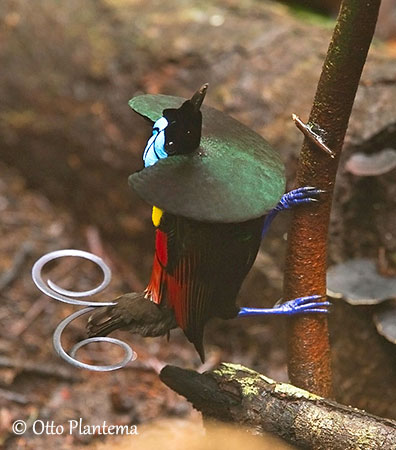
When a female is interested, she perches on the branch above the male and she looks at him while it is weaving back and forth, calling and flexing its fluorescent breast shield, similar to a brilliant green disk.
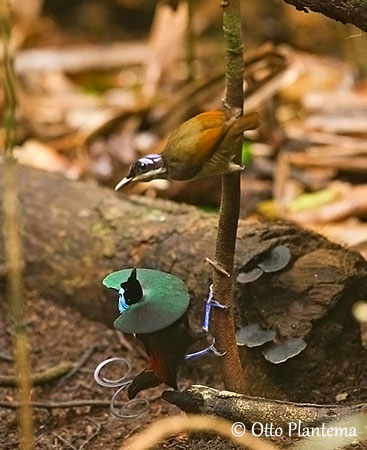
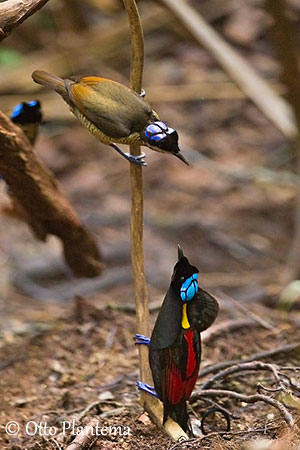
Following the copulation, the female leaves the area. She builds the nest alone and tends the brood without any help from the male which returns to the court to attract other females.
The Wilson's Bird-of-paradise is probably resident with perhaps short altitudinal movements. But more information is needed.
The adult male makes a sharp and clear clacking noise while flying about its court. We do not know how this noise is produced, but it is possible that the more or less modified outer primaries of several genera create some wing noise during the flight. This behaviour needs more information.
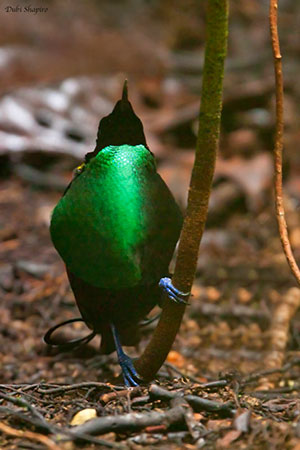
REPRODUCTION OF THIS SPECIES:
The breeding behaviour of the Wilson's Bird-of-paradise is poorly known. Males appear to be ready to breed in May-June and October, and the females in June.
The period of courtship displays is undefined.
The adult female builds and tends the nest alone, protected by her very cryptic plumage.
The polygynous species usually produce 1 or 2 eggs, and the incubation lasts from 14 to 27 days, depending on the species. The nestling period varies from 14 to more than 30 days. The chicks are usually fed by regurgitation.
No more information.
PROTECTION / THREATS / STATUS:
The Wilson's Bird-of-paradise is threatened by heavy degradation of the habitat on Batanta, caused by logging, but the species is uncommon in logged forests and probably safe at higher elevations.
There are no serious immediate threats to the forests on Waigeo, due to the rugged relief.
The population size is unknown, but it is suspected to be slowly declining, due to forest loss and degradation of the habitat.
The Wilson's Bird-of-paradise has restricted range and the species is currently classified as Near Threatened.
